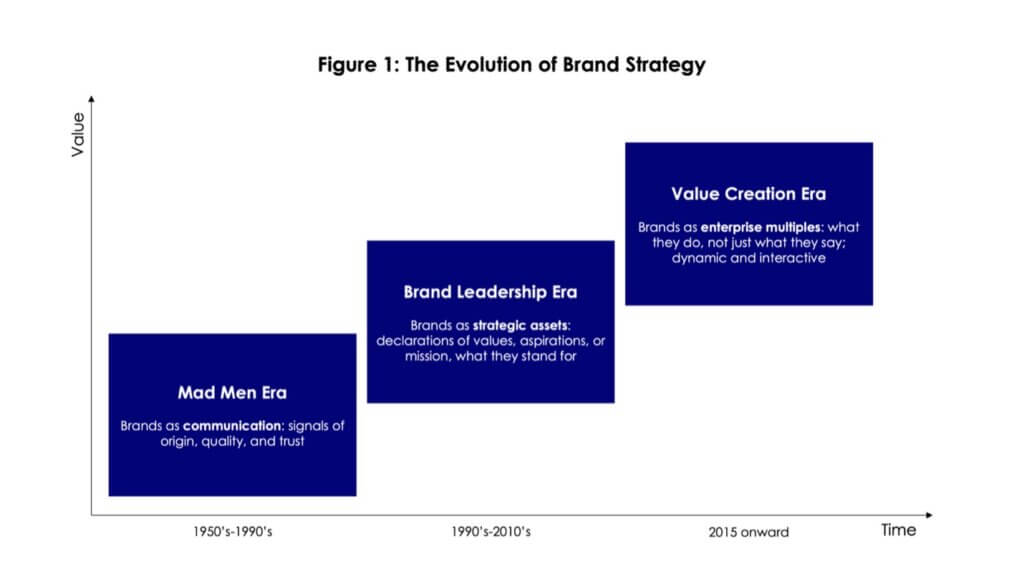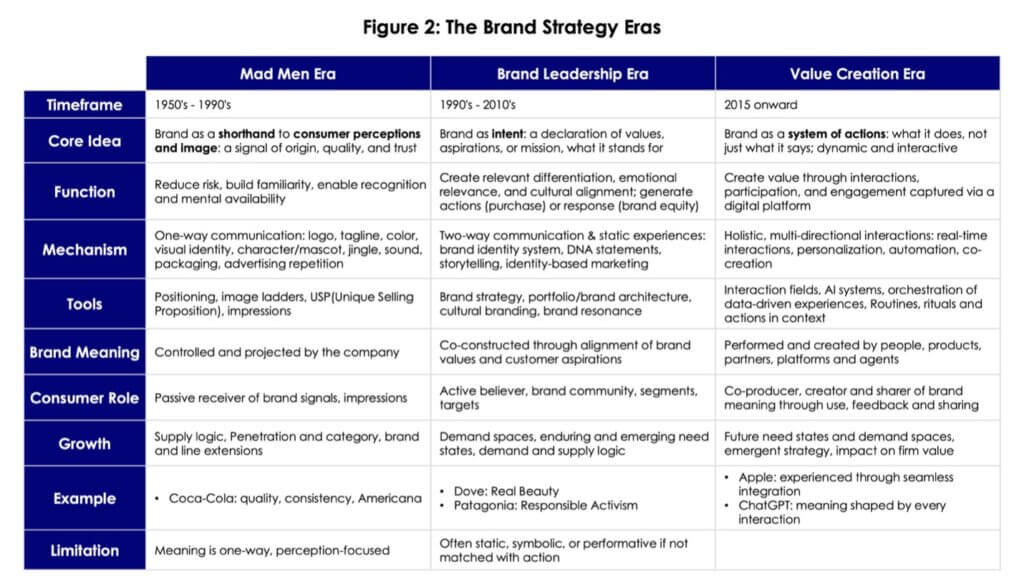Over the past decades, the discipline of brand strategy has undergone a profound transformation—emerging from the “Mad Men” era of advertising into a dynamic engine of enterprise-wide value creation (see Figure 1). In its earliest conception, the brand was defined primarily by communications—its identity shaped by what was said about it in mass media. Yet even then, a powerful idea began to take hold: brands are assets, albeit intangible ones, with impact on consumer behavior and real financial results.
This insight gave rise to the concept of brand equity—defined as the differential consumer response to a brand versus an unbranded alternative. That shift—from brand as image to brand as an asset—laid the foundation for a new discipline: brand strategy.
Brand strategy replaced advertising as the dominant force in brand building. It introduced a long-term view of what the brand stands for and what it seeks to create. Strategy, by definition, is about making choices. It is about setting a direction and accepting trade-offs. Patagonia, for example, chooses to prioritize environmental and social values over low-cost production. That choice positions the brand at a premium, distinct from fast fashion. Similarly, Apple has built its brand around minimalist design, simplicity, and user-centric experiences—attributes that justify its price premium. These are deliberate brand trade-offs.
To understand how brand strategy has matured, it is helpful to examine its evolution in three distinct eras:
1. The Mad Men era: Brands as communication
Brand strength was built through advertising, slogans, and imagery. The focus was on consistency, recognition, and emotional resonance created through media and storytelling. However, branding in this era was often just about creating an unconvincing veneer of trust, emotions, or other benefits to convince consumers to consider a purchase. The brand’s job ended with creating strong mental associations, driving purchases, and fostering a relationship with consumers.
2. The Brand Leadership era: Brands as strategic assets
In this phase, brands became central to business strategy. The concept of brand equity guided management, and brand architecture, positioning, and differentiation became core practices.
3. The Value Creation era: Brands as enterprise multipliers
We are now in a new era—one that redefines the power of brands and their roles in the world as an amplifier of the overall financial results of the firm. Brand strategy today is not just about managing perceptions or goodwill or extracting value from consumers through price premiums. It is about creating value—across the entire firm and its ecosystem, an interest on all your invested capital.
In the Value Creation era, the brand is a multiplier and accelerator of business and financial performance, delivering future pricing power. It is foundational to future growth not just through marketing, but through product innovation, partnerships, platforms, and business model transformation.
This era moves us beyond static, linear, and rigid brand planning about a future aspiration toward dynamic orchestration—where brand value is created continuously through interactions, behaviors, and experiences as part of an overall architecture and system of growth of a business or ecosystem.
The brand is no longer what it says—it is what it does across this system. Every click, every swipe, and every touchpoint contribute to how a brand is perceived and experienced. In this model, we define the brand not as a message, but as an Interaction Field—a living system of connections between people, platforms, products, and agents (human and algorithmic).

In this new paradigm:
- The brand is co-created through participation in a larger system of actions. It is not just treated as an intangible asset that is important and correlates with financial performance; it is not just about storytelling, cultural resonance, or relevance, but it is about the system of how the story is delivered. AI systems capture the interactions and continuously optimize, creating value that compounds over time.
- It is ultimately measured by the value for the firm and the value, it generates—not just for consumers, but for partners, platforms, the firm and the broader ecosystem – in terms of long-term value creation aligned with corporate performance metrics, the intrinsic value of a firm based on earnings, growth potential and cashflow, and not short-term vanity metrics or performance marketing tactics.
- It behaves dynamically, adapting to context, situations, need states, culture, and stakeholder input and evolves the brand meaning accordingly, powered by data, analytics and technology.
In short, brand building has shifted from the realm of communications, where the brand was seen as a soft asset, superficial and expendable, limited to the tactics and short-term metrics of performance marketing, to the domain of real market and tangible financial performance. Today, the brand is viewed as an economic engine, an operating system that lubricates and optimizes the entire business or ecosystem. It is not just the brand’s story that creates value, but its actions, behaviors, and the network of interactions it activates. This strategic shift defines the new era of brand strategy beyond a promise or reputation, and ultimately, it is what drives long-term and intrinsic firm value.

